
We are celebrating 15 years — and counting — of stories that are deeply researched and deeply felt, that build a historical record of what the city has been.
We are celebrating 15 years — and counting — of stories that are deeply researched and deeply felt, that build a historical record of what the city has been.
In February, we announced our second annual writing competition, this year on the topic of cost, metrics, and measurement in urban life. We asked entrants to explore or respond to — through narrative, theory, history, or humor — the increasingly quantitative language that pervades contemporary analysis of behavior, consumption habits, settlement patterns, environmental imperatives, or quality of life. The competition jury selected one winning essay and two runners-up. The winner of the competition, “The City That Never Shouts” by Steven Higashide, imagines a near feature in which a new City agency, the Department of Externalities, monitors and evaluates the social and environmental effects of everyday actions. In “Little Metrics,” runner-up Malaika Kim traces how the intangibles of her life — the passage of time, the acquisition of knowledge, and changes in lifestyle and family — have shifted her perception and experience of the physical environment in very measurable ways.
Today, we are pleased to publish the other of our two runners-up: “The Ricotta Index,” by Deborah Helaine Morris. In her essay, below, Morris charts the shifting demographics of one pocket of Brooklyn using an indicator that is, now more than ever, ubiquitous in contemporary discussion about New York City: the culture of food. But instead of tracking the clichéd harbingers of gentrification, such as the appearance of a Starbucks or an American Apparel, Morris, a native New Yorker, went to her local supermarkets, mom-and-pop delis, and artisanal food stores to see how neighborhood change is reflected in the dairy aisle. In so doing, she offers a glimpse into a changing community through a survey of the quality, production, and price of a simple, and delicious, ingredient.
This is a story about ricotta and a neighborhood. I moved to Carroll Gardens in 2005. I was attracted to Carroll Gardens because it combined the novelty of a brownstone-living experience with the familiar resources of an ethnic enclave like the one where I grew up in Queens. Court Street was lined with small specialty shops, groceries packed with imported olive oils, bakeries fragrant with anise cookies, pork stores for spicy house-aged sausages, and latticinis for fresh pasta and cheese.
Caputo’s, on Court and 4th Place, became my destination for mozzarella and fresh ricotta. Caputo’s is a narrow box of a shop. Refrigerators filled with hundreds of varieties of pasta, many stuffed with ricotta, line one wall. Balls of fresh mozzarella bathe in plastic tubs of whey on the counter. A grandfatherly figure kneaded mozzarella and strained the ricotta and pot cheese. A teenage boy ran the register. And the ricotta — oh the ricotta — it was divine. And, as I remember it, cheap, maybe three dollars for a single pound.
Ricotta is a product of thrift. Whey, left over from some prior cheese-making endeavor, is curdled with a little lemon, and small clumps of protein magically emerge from the cloudy fluid. The Latin recocta means re-cooked, referring to the re-use of the whey. Similar cheeses like requesón and farmer’s cheese do not compare to truly fresh ricotta. Ricotta is versatile, equally delicious as a spread, a sauce, mixed with a vegetable as pasta filling, or just scooped out of a bowl with a spoon. It is my favorite cheese.
Although ricotta is a simple cheese, it represents the nuanced landscape of grocery shopping in New York City. First, there are grocery stores, large and small, that offer the range of branded and generic products that can dutifully stock anyone’s pantry. Although the prices of products in big grocery stores might vary across the city, this is generally a reflection of underlying real estate or brand power more than anything else. Next, there are a multitude of regional, ethnic, and specialty items, catering to the cooking interests of specific groups. These stores are often in historic enclaves, and tend to be price conscious, targeting recent immigrants and price-sensitive shoppers. Finally, there are the luxury grocers, like Dean & DeLuca, offering exquisite examples of the finest foods to discerning customers who want the best and are willing to pay for it, from Beluga caviar to a varietal honey harvested in the Pyrenees.
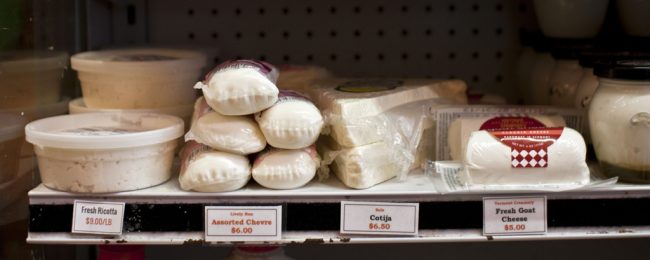
StinkyShelf | Photo by Kaori Ogawa
The ricotta in New York City used to fall into two categories. Mass-produced Polly-O ricotta, available in most grocery stores, is dry, grainy, and tasteless. The second kind, hand-strained ricotta, like that sold at Caputo’s, is made from the whey leftover from mozzarella. It is luscious, sweet, and, almost trembled on a spoon.
In 2007, I left Carroll Gardens to study urban planning. I returned in 2009, my head pulsing with new theories of urban form and a heightened awareness of gentrification. All of my favorite stores were still there, although the Blockbuster was gone, replaced with a new, fancy, full-service grocery store. I wandered in, attracted to the large displays of fresh produce, which bore no resemblance to the wilted displays at the Key Foods that closed in 2006. This store had Meyer lemons! And such a variety of cheeses from around the world, including fresh ricotta made in Brooklyn by a couple who had been inspired by a charming man in San Gimignano. This ricotta was made in small batches with fresh milk from upstate New York, not from leftover whey. This product had a story and attractively designed packaging. It was artisanal. It was $16 per pound. Now there was a ricotta product that fell into a third column of grocery items: luxury good.
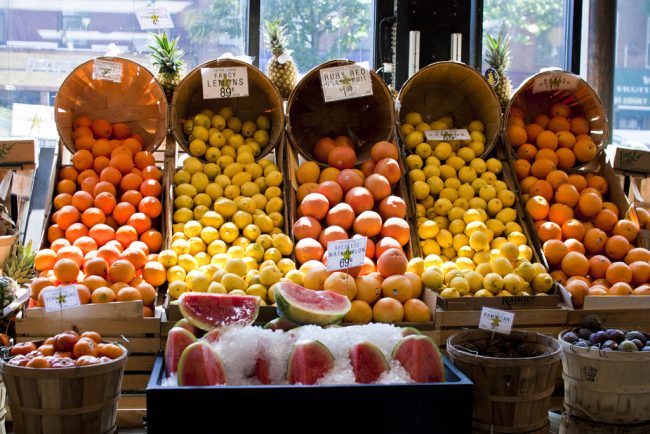
Union Market | Photo by Kaori Ogawa
Being a woman of open mind, I tried the upmarket ricotta. I can report that it was different than the ricotta to which I was accustomed. It was denser, and perhaps slightly creamier. Too rich for me to use as a utilitarian meal filler, I wasn’t sure how to eat it. But I did.
Beyond ricotta, there are other ways I noticed the neighborhood food purveyors adapting to the new population. Every bodega now offers selections of Kashi cereals, organic laundry detergent, and recycled toilet paper. Although I had remembered one pet supply shop, now there are three, not to mention two doggie day cares. A Dunkin’ Donuts replaced Leonardo’s pizzeria but kept its shrine to Joseph. There were more restaurants, and there were fewer vacant storefronts south of Luquer Street. Without question, Carroll Gardens had changed.
At my beloved Caputo’s, still open, fresh ricotta was $3.49 a pound. Caputo’s still seemed to be busy with a loyal clientele of aging Italian grandmothers wearing orthopedic shoes as well as a few younger customers in fancy sneakers.
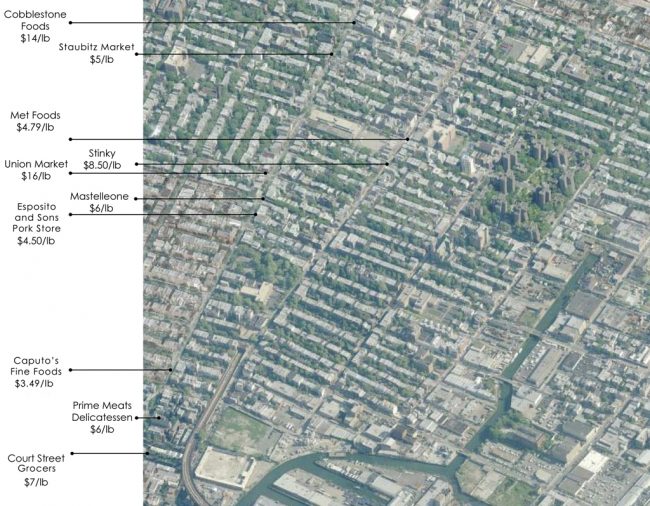
Diagram by Deborah Helaine Morris
I became obsessed with ricotta prices. Last summer, I walked up Court and down Smith, looking for fresh ricotta, looking for meaning. Several of the old-generation Italian groceries still sold house-made, or at least Brooklyn-made, ricotta, for prices ranging from $4.50–$6.00 per pound. Polly-O and other nationally distributed ricottas were available for $4–$6 a pound at the Met Foods on Smith Street and at the Key Foods on Atlantic Avenue. Besides the new grocery store, there are two new food boutiques, each purveying a local ricotta for $14-$16 per pound.
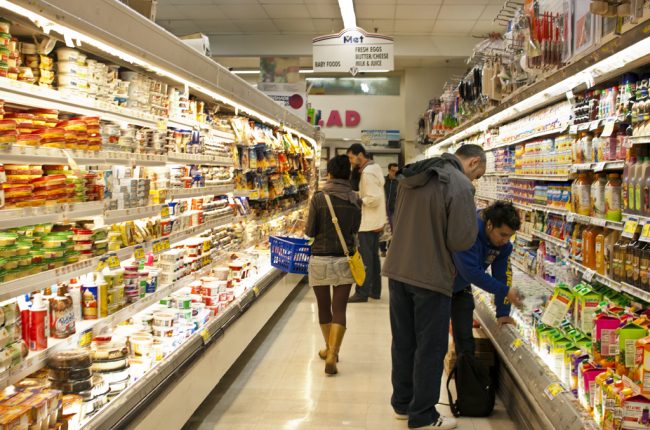
Met Food | Photo by Kaori Ogawa
Besides noticing this dramatic variation in ricotta quality and price, I noticed that the people were different. There were far more people my age, far more young families, the playground was suddenly packed. Oddly, French had become as common as Sicilian in Carroll Park. Carroll Gardens still had it is charming historic brownstones and its small shops catering to its historically Italian residents. But it had also made room for new a new population, with different needs, and a taste for a different kind of ricotta.
I am not certain that cheese is the best indicator of neighborhood change. But every time I step into a store with comestibles, I head straight to the dairy section, and try to see what the offerings can tell me about where I am or, at least, what I should have for dinner.
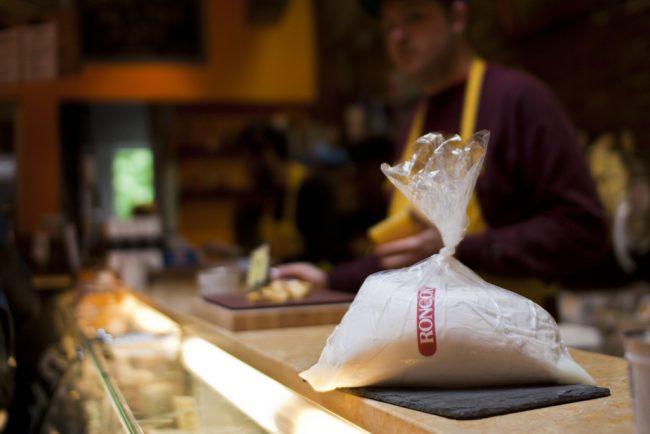
Stinky Bklyn | Photo by Kaori Ogawa
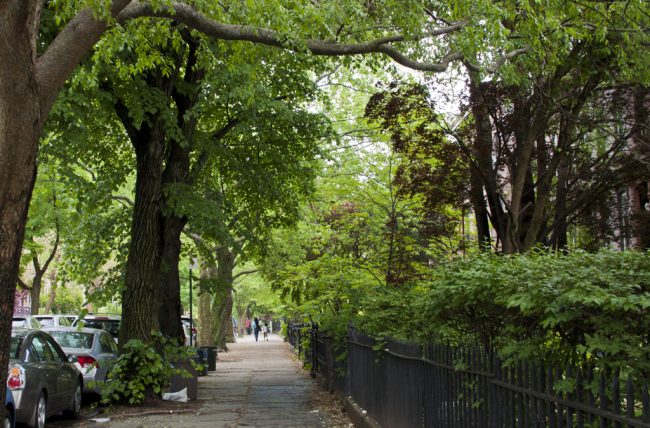
Carroll Gardens | Photo by Kaori Ogawa
The views expressed here are those of the authors only and do not reflect the position of The Architectural League of New York.